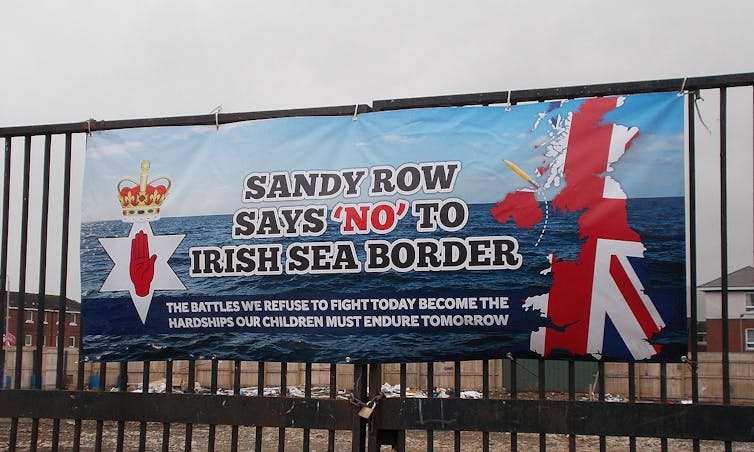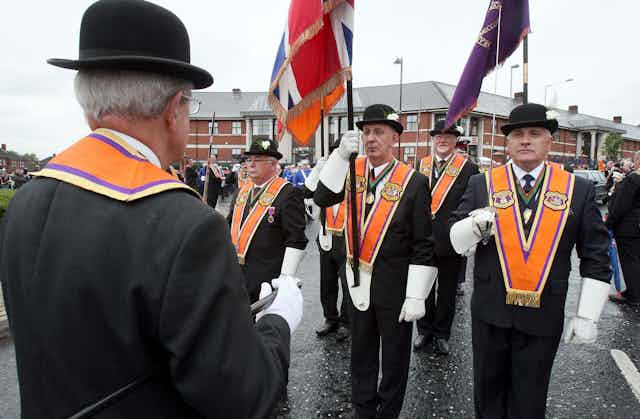Earlier this year, disorder in Northern Ireland reached a scale not seen in years, with a wave of protests and violent riots. These actions were a manifestation of loyalist anger at the border created in the Irish Sea, a result of the Brexit deal. The demonstrations also articulated increasing loyalist dissatisfaction with the Stormont Assembly and the Police Service of Northern Ireland.
Commentators warned that Northern Ireland is facing a “long hot summer of loyalist protest parades” against the Northern Ireland Brexit protocol, which introduced checks on goods entering the region from Great Britain. There have been dozens of unlawful parades against the Irish Sea border across the region in the past few months.
It is perhaps no surprise that police have already put in place contingency plans should violence flare during next week’s Twelfth of July demonstrations. These parades happen yearly, marking the climax of the Ulster Protestant marching season.
While only a small proportion of Orange Order parades on the Twelfth have been contentious in the past, there are fears that tensions this year could be inflamed by loyalists seeking to force the UK government to abandon the protocol.
Online platforms have played a key role in the mobilisation of these protests, helping spread information about their location as well as images and video. There are concerns that young people in working class, loyalist areas are being manipulated by “fake social media accounts”. Facebook was forced to remove several pages used by loyalist agitators to encourage young people to protest at sectarian interfaces in April. Meanwhile, online commentators condemned footage of protest-related violence circulating on sites like Twitter.
As I argue in my new book, social media empowers citizens to comment publicly on contentious parades and protests. These people, connected via feelings of belonging and solidarity, both help and hinder efforts to moderate sectarian tensions caused by these demonstrations. Online hate speech and misinformation undermine efforts to promote reconciliation in Northern Ireland. However, citizens and journalists also use these platforms to correct misinformation that might spark violence.
Following along
I am sure I will not be the only one doomscrolling Twitter during the Twelfth. Given that we spend so much of our lives online, it is no surprise that we experience such events vicariously through the journalists and eyewitnesses who document them using their smartphones.
So, how can we ensure we don’t exacerbate the tensions underpinning these protests? Based on my research on the role of social media during the flag protests and the Ardoyne parade dispute, here are some tips on how to use social media to find (and, if you must, share) information about parades, protests and related violence:
1. Know where to look
First, an obvious one. Changing your Twitter trends to “Belfast” is a good place to start. Following the social media profiles of news outlets and professional journalists will at least ensure that the information you are getting has come from a reputable source, and help you avoid the rumours and disinformation frequently spread on these platforms.
2. Check before you share
This is particularly important when other people share information into our feeds or group chats, and we cannot verify the identity of the source. During the violence in April, messages on Facebook and WhatsApp entitled “Calling of Arms” urged loyalist youths to “earn their strips” [sic] by participating in street demonstrations. Loyalist commentators condemned these posts as “malicious and false”. The toolkit provided by FactCheckNI, the region’s only fact-checking organisation, is a useful guide for assessing the veracity of online information.

3. Approach ‘hot takes’ with caution
While no stranger to writing rapid response pieces myself, I am keenly aware that these can date very badly and are rarely based on an in-depth appraisal of the facts. Commentators will react to traces of behaviour visible on social media sites, but will be unable to contextualise these events or fact check them in real time given their physical distance.
In many cases, “hot takes” are “literally unsolicited opinions backed up with no fact or research whatsoever”. Consider for example how prominent critics of Brexit like Femi Oluwole have been criticised for reductively framing the protests and violence as being solely about the protocol, at the expense of more nuanced analyses that acknowledge that loyalist disillusionment with the peace process goes back much further than the 2016 Brexit referendum.
4. Play the ball, not the person
The final tip is perhaps the most important. This is a minor paraphrasing of Mick Fealty’s netiquette for the Slugger O’Toole weblog, which an interviewee of mine (who will remain nameless) a few years ago memorably abbreviated into: “Don’t be a dick.” The crude stereotyping of the “other” community will do little to build trust and reciprocity in what remains a divided society.

